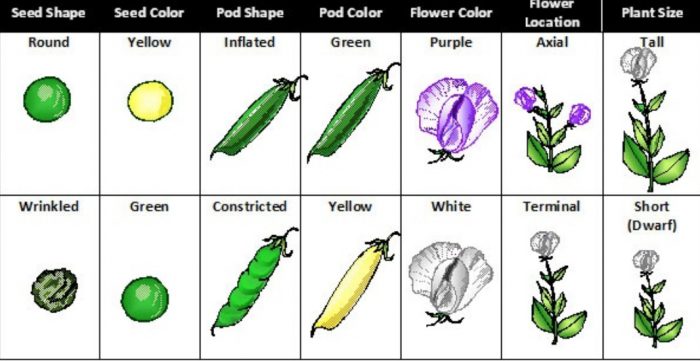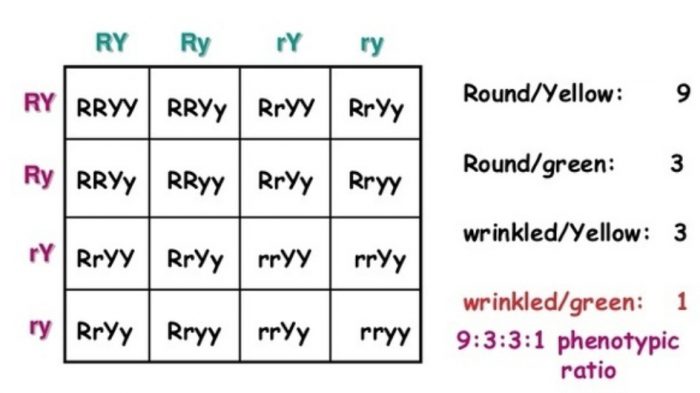Question 1 Define the term heredity, variations and genetics?
Question 2 Why Mendel selected garden pea plant for his experiments?
Question 3 Explain the Mendel monohybrid cross?
Question 4 Explain the Mendel dihybrid cross?
Question 5 Explain the contribution of Mendel in Genetics?
Question 6 State law of segregation ?
Question 7 State law of independent assortment?
Question 8 Briefly describe Mendel’s experimental technique?
Question 9 Define contrasting characters?
Question 10 What precautions were taken by Mendel during his monohybrid and dihybrid crosses?
Question 11 Define the term dominant and recessive character?
Every organism produces offsprings either through asexual reproduction or through sexual reproduction.
In asexual reproduction all the offsprings resemble each other and also to their single parent, yet very minor differences (variations) arise in them.
In most animals including human beings that reproduce sexually, offsprings do look like their parents but they are not exactly identical. Also, they do not exactly resemble each other.
Origin of life on earth around 3-6 billion years ago is believed to have originated from inanimate matter by a series of chemical reactions on the primitive earth. The earlier simple living forms evolved through gradual and continuous change and gave rise to enormous diversity of microorganisms, algae, fungi, plants and animals on this earth.
The branch of biology that deals with the changes and its causes in the diversity of living organisms over the period of time is called evolution.
Contents
Heredity and Variations
The similarities and difference among the members of a species are not coincidental. They are received by the young ones from their parents. The hereditary information is present in the gametes (egg and sperm) which fuse to form the fertilised egg or zygote during sexual reproduction. The zygote then develops into an organism of a particular type.
Heredity : Transmission of characters (resemblances as well as variations) from parents to the offsprings, i.e. from one generation to the next is called heredity.
Variations: The differences shown by the individuals of a species, and also by the offsprings (siblings) of the same parents are referred to as variations.
Genetics :It is the study of heredity and variations.
Accumulation of Variations During Reproduction
Heredity involves inheritance of basic body design (similarities) as well as variations in it from one generation to the next generation i.e. from parents to the offspring. When individuals of this new generation reproduce, the offsprings of second generation will have the basic body design, the differences that they inherit from first generation as well as newly developed differences.
Asexual reproduction involves single parent. When a single individual reproduces asexually, the resultant two individuals again after sometime reproduce to form four individuals. All these individuals would be similar.
Sexual reproduction generates even greater diversity. This is so because sexual reproduction involves two parents (father and mother) and every offspring receives some character of father and some characters of mother. Since, different offsprings receive different combination of characters of their parents (father and mother), they show distinct differences (variations) among themselves as well from their parents.
All these variations in a species do not have equal chances of surviving in the environment in which they are generated. Depending upon the nature of variations, different individuals would have different kinds of advantages.
Mendel’s Contributions
Gregor Johann Mendel studied the inheritance of contrasting characters (traits) such as tallness/dwarfness of plants, round/wrinkled form of seeds, axillary terminal position of flowers, yellow/green colour of seeds, white/violet colour of flowers etc. by working on garden pea plant (Pisum sativum)
Mendel’s Experimental Plant
Mendel selected garden pea plant (Pisum sativum) for series of hybridization experiments because it had the following special features:
(1) It had a short life cycle and, therefore, it was possible to study number of generations.
(2) Garden pea plant had distinct, easily detectable contrasting variants of features.Some plants were tall and some dwarf , some had violet flowers and some had white flowers, some plants had round seeds and some had wrinkled seeds and so on.
Mendel noted seven pairs of such contrasting characters in garden pea plant.
The characters which always appear in two opposing conditions are called contrasting characters.
(3) All the contrasting traits were existing in every generation because plants had bisexual flowers and normally resorted to self-pollination.
(4)In these bisexual plants, artificial cross fertilization could easily be achieved.
(5) Each pea plant produced many seeds in one generation.
(6) The garden pea plants could easily be raised, maintained and handled.
Mendel’s Experimental Technique
Mendel conducted breeding experiments in three step:
(1) Selection of pure parent plants (i.e., plants producing similar traits in every generation).
(2) Production of first generation of plants by cross breeding (hybridization)
(3)Raising of second and subsequent generations by self-fertilization of hybrids.
Precautions taken by Mendel
(1) He always focussed on the inheritance of the specific traits under consideration and simply ignored others.
In his crosses, only one trait, i.e. size of plant (tall or dwarf) or colour of flower (violet or white) etc. was considered. He called such crosses as monohybrid crosses.
(2) Mendel also conducted crosses considering two or more contrasting traits of garden pea plant simultaneously.
(3) He avoids self-fertilization between two varieties or traits of plants.
Mendel removed the anthers (male parts) of the flowers well before the maturity of the female part, i.e., gynoecium of the flowers. Such flowers were covered to avoid entry of any foreign pollen grain from outside by wind or animals.
For making a desired cross, mature pollen grains from the anther of the flower of the desired plant were transferred on the stigma (female part) of the emasculated mature flower. The seeds formed by such crosses were collected.
These seeds belonged to the first filial generation or F1 generation. Mendel used the seeds of F1 generation to raise the F2 generation by self pollination and also the F2 seeds for raising F3 generation by self pollination.
Mendel’s Monohybrid Cross
A breeding experiment dealing with a single character is called a monohybrid cross.
(1) Mendel first selected pure line plants i.e. the plants that produced similar traits generation after generation.
(2)He then cross pollinated such plants having the contrasting traits, considering one trait at a time. In one such cross breeding experiment, he cross bred garden pea plant having round seeds with plant having wrinkled seeds.
(3) In this monohybrid cross, the pollen grains from the flower of the desired plant raised from round seeds were transferred over the previously emasculated flower of a plant raised from wrinkled seeds or vice-versa.
(4) After the transfer of pollen grains, the cross pollinated flower was properly covered and seeds produced were allowed to mature.
(5) All the seeds of F1 generation were carefully observed. Mendel observed that all the seeds of F1 generation were of round type and there were no intermediate characteristics.
(6) He raised plants from F1 seeds and allowed the flowers to self-pollinate to produce the seeds of F2 generation.
(7) In F2 generation, Mendel observed the appearance of both round and wrinkled seeds in approximately 3: 1 proportion.
Mendel’s Dihybrid Cross
A breeding experiment dealing with two characters at the same time is called a dihybrid cross.
(1) Mendel considered shape as well as colour of the seeds simultaneously.
(2) He selected pure line plants and then cross pollinated flowers raised from seeds of round shape and yellow colour with those from wrinkled seeds and green colour.
(3) Mendel observed that in F1 generation all seeds had the features of only one parental type, i.e. round shape and yellow colour.
(4) He raised plants from F1 generation seeds and allowed the flowers to self pollinate to produce the seeds of F2 generation.
(5) These flowers were kept covered from the beginning. In F2 generation, Mendel observed the appearance of four types of combinations. These included two parental types (round shaped and yellow coloured seeds, and wrinkled shaped and green coloured seeds) and two new combinations (round shaped and green coloured seeds, and wrinkled and yellow coloured seeds) in approximately same proportion.
Mendel’s Conclusions
(1) In a monohybrid cross, only one of two contrasting characters (traits) appeared in F1 generation.In F2 generation, both the parental traits appeared in certain proportion.
(2) In a dihybrid cross, when two contrasting pairs of traits were considered simultaneously, only one parental combination appeared in F1 generation. However, in F2 generation, raised by self-pollination, four combinations of traits appeared. These included two parental type traits and two new combinations in approximately same proportion.
Mendel’s Interpretation
Mendel postulated that:
(1) There are a pair of unit factors controlling each character in pea plant, one inherited from each parent. Mendel considered these factors as the carriers of hereditary information from one generation to another. At the time of reproduction, when gametes are formed, these factors segregate so that each gamete receives only one factor of each character. This is called law of segregation.
(2) In F1 generation, only one character was expressed. Mendel called it as dominant character. The character which was not expressed was termed recessive character. This phenomenon of appearance of only one of two contrasting traits in F1 generation, is termed as dominance.
(3) The characters are not lost even when they are not expressed.
(4) When F1 offsprings were allowed to be self pollinated, both the parental traits were expressed in definite proportion in F2 generation.
(5) From the F2 generation of a dihybrid cross, Mendel postulated that inheritance of factors controlling a particular trait in an organism are independent of the other. This is called law of independent assortment. At the time of reproduction, two pairs of factors of each of the two traits in a dihybrid cross segregated independently during gamete formation and randomly formed combinations in the F2 generation. This is why new combinations appeared along with parental combinations.



very nice expanations
Thanks ji
Thank you very much for this ,this notes are really very helpful for me.
Thank you!